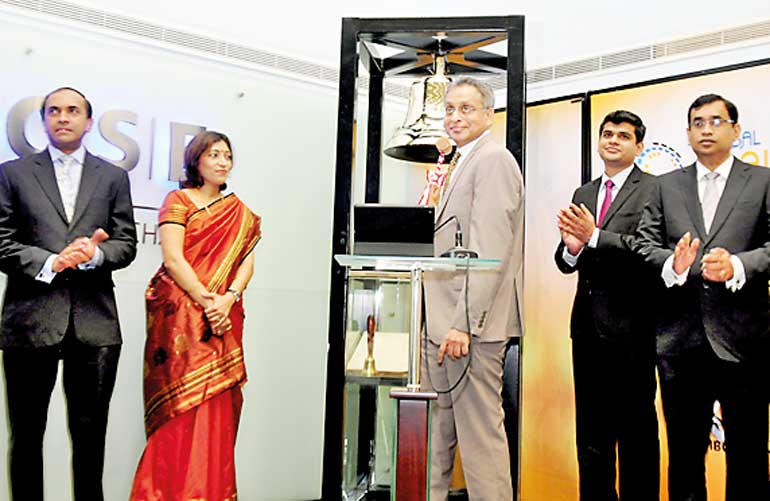Thursday Apr 24, 2025
Thursday Apr 24, 2025
Thursday, 7 April 2016 00:15 - - {{hitsCtrl.values.hits}}

From left: CSE CEO Rajeeva Bandaranaike, S&P Dow Jones Indices in South Asia Head of business development Koel Ghosh, CSE Chairman Vajira Kulatilaka, S&P Dow Jones Indices Senior Manager for Products Mahavir Kaswa and CSE Head of Research and New Products Nishantha Hewavithana – Pic by Lasantha Kumara
By Shehana Dain
In a bid to woo more foreign investors, the Colombo Stock Exchange (CSE) and S&P Dow Jones Indices yesterday jointly launched 31 S&P/CSE Sector and Industry Group Indices.
Taking a step forward to internationalise the stock market and increase visibility, CSE Chairman VajiraKulatilakesaid he expects this move to increase the chances of the Colombo Bourse being a regional player with stronger comparability measures.
Noting that the move would put Sri Lanka on the global map as the CSE adheres to Global Industry Classification Standards (GICS), Kulatilake said that the new indices would make decision making clearer for foreign investors.
“For international investors, it is difficult to find out what standard or what category a particular company is in; we may categorise a company as manufacturing because it’s manufacturing food, however internationally it could be classified under food. Therefore classification is essential for diversification purposes.”
Following the initial launch of the indices classification on 2 December last year, the pilot project will be evaluated for a period of one year. Meanwhile daily indices and statistics will be presented taking the first trading day 4 January as the base date.
Addressing the gathering, S&P Dow Jones Indices South Asia Business Development Director Koel Gosh pointed out that this step would definitely move the Sri Lankan market to global norms and open up the market to more investors.
“There was a crying need to have a universal language to invest as an individual can be investing on the same stock with different definitions. GICS was the solutionfor that. GICS is a progressive classification, which is based on client consultation; there is active change that keeps on happening. Today you have 10 sectors, 24 industry groups, 67 industries and 156 sub-industries; by August 2016 you will see this become 11 sectors and 157 sub-industries because we’re adding real estate as a separate sector,” Gosh pointed out.
She insisted that the CSE was one of the frontier markets in which the financial community was eager to grow faster.
“The CSE first introduced the co-branded index and now it is extending it to GICS so I think it is definitely creating the platform for better trading; it’s up to the investors to pick it up.”
Indices are published on energy, materials, industries, consumer discretionary, consumer staples, health care, financial sector, information technology, telecommunications and utilities; whilethere will be 21 industry group indices.
In that context within the financial sectorthere are indices covering the banking industry group index, diversified financials industry group index, insurance industry group and real estate industry group index.
The GICS structure consists of 10 sectors, 24 industry groups, 67 industries and 156 sub-industries into which S&P has categorised all major public companies. CSE Head of Research and New Products Nishantha Hewavithana stated that when the 288 listed companies in the Colombo Bourse were put into the structure, only 61 of 156 sub industries matched the criteria.
S&P DJI and CSE started their collaboration in 2012 when they jointly introduced the S&P SL 20and investible index comprising the 20 largest and most liquid stocks listed on the CSE.
Discover Kapruka, the leading online shopping platform in Sri Lanka, where you can conveniently send Gifts and Flowers to your loved ones for any event including Valentine ’s Day. Explore a wide range of popular Shopping Categories on Kapruka, including Toys, Groceries, Electronics, Birthday Cakes, Fruits, Chocolates, Flower Bouquets, Clothing, Watches, Lingerie, Gift Sets and Jewellery. Also if you’re interested in selling with Kapruka, Partner Central by Kapruka is the best solution to start with. Moreover, through Kapruka Global Shop, you can also enjoy the convenience of purchasing products from renowned platforms like Amazon and eBay and have them delivered to Sri Lanka.
Discover Kapruka, the leading online shopping platform in Sri Lanka, where you can conveniently send Gifts and Flowers to your loved ones for any event including Valentine ’s Day. Explore a wide range of popular Shopping Categories on Kapruka, including Toys, Groceries, Electronics, Birthday Cakes, Fruits, Chocolates, Flower Bouquets, Clothing, Watches, Lingerie, Gift Sets and Jewellery. Also if you’re interested in selling with Kapruka, Partner Central by Kapruka is the best solution to start with. Moreover, through Kapruka Global Shop, you can also enjoy the convenience of purchasing products from renowned platforms like Amazon and eBay and have them delivered to Sri Lanka.